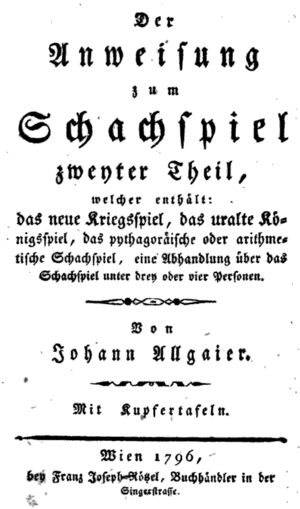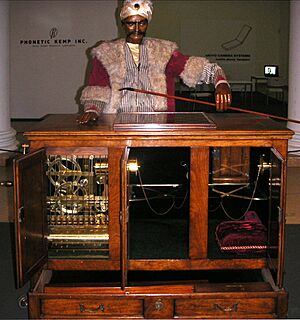Johann Baptist Allgaier facts for kids
Johann Baptist Allgaier (born June 19, 1763, in Schussenried, died January 3, 1823, in Vienna) was a German-Austrian chess master. He was also a chess writer. He wrote the first chess book in German, called Neue theoretisch-praktische Anweisung zum Schachspiel (Vienna 1795–96).
Contents
Allgaier's Life Story
Not much is known about Johann Allgaier's life. Many details, even his birth and death dates, were lost soon after he died. It took a lot of searching by people like Anton Baron Reisner in the 1870s to find out more about him. Reisner talked to Allgaier's family and others who knew him.
Johann Baptist Allgaier was born in 1763 in the Duchy of Württemberg. His first language was the Swabian dialect of German. His father worked at a monastery, teaching children from rich families. Johann was meant to study theology, which is the study of religion.
However, after a trip to Poland, he learned chess from a Polish Jew. Chess quickly became his main interest, more important than his studies.
Moving to Vienna and Army Life
In 1798, Allgaier moved to Vienna and joined the army. In Vienna, he became much better at chess. Around 1780, he won an important chess match. He won 1,500 florins (a type of money back then) and became known as the best chess player in the city.
This success helped him meet important people in Vienna. He started giving chess lessons to the children and brothers of Emperor Francis II.
Allgaier fought in the Napoleonic wars between Austria and France. In 1809, he worked in a military hospital. There, he got sick with a long-term breathing problem called asthma. Later, he moved to Prague and worked as an accountant at a military hospital.
He returned to Vienna in 1816. The Emperor gave him a small pension because of his health. To earn more money, Allgaier played chess in Vienna's coffee houses. One famous place was the Zur Goldenen Krone, where many strong players met.
His Chess Style and the Turk
People who watched Allgaier play said his style was exciting and focused on attacking. He would often accept challenges for one florin. If a weaker player challenged him, they would also get a short lesson after the game.
Allgaier often struggled with money. Because of money problems, some chess players agreed to operate Mälzel's famous chess machine, the Turk. This machine looked like a robot that could play chess. A person would hide inside and control it. Allgaier played hidden inside the Turk in 1809. A game played by the Turk against Napoleon at Schönbrunn Palace that year is thought to have been played by Allgaier.
Allgaier died on January 3, 1823, in a military hospital in Vienna. He suffered from dropsy, a condition where the body swells. The fact that he died in a public hospital, even though he was married, shows he likely had very little money.
Allgaier's Impact on Chess
| This section uses algebraic notation to describe chess moves. |
In 1795 and 1796, Allgaier published his chess book, Neue Theoretische-praktische Anweisung zum Schachspiel, in Vienna. This book was considered one of the best chess textbooks of its time in some parts of Europe. It was printed many times, even after he died. The last edition came out in 1843.
Allgaier knew a lot about the chess ideas of his time. He was influenced by the ideas of Philidor and the Modenese School. The Modenese School included players like del Rio, Lolli, and Ponziani. Allgaier tried to combine their ideas. Philidor's influence was stronger, and Allgaier was sometimes called the "German Philidor."
Allgaier especially liked having more pawns on the kingside (the side of the board where the king starts). He believed this was a big advantage because these pawns could move forward to attack the opponent's king.
Allgaier's Playing Style
Allgaier's own games show that he preferred a very tactical style of play. This means he liked games where pieces attacked each other quickly and violently. This is different from Philidor's slower, more pawn-focused style.
The chess opening named after him, the Allgaier's Gambit, is a very sharp and aggressive opening. It starts with the moves: 1.e4 e5 2.f4 exf4 3.Nf3 g5 4.h4 g4 5.Ng5. After 5... h6, White often sacrifices a knight with 6.Nxf7, leading to a very tactical game.
In later editions of Allgaier's book, some games played by strong Vienna players were added. It is believed that many of these games were played by Allgaier himself. These games are quite rare.
First Game
1.e4 e5 2.Nf3 d6 3.Bc4 f5 4.d4 fxe4 5.Nxe5 Nh6? 6.Bxh6 dxe5 7.Qh5+ Kd7 8.Qf5+ Kc6 9.Qxe4+? 9...Kb6 10.Be3 exd4 11.Bxd4+ c5 12.Be3 Nc6 13.Nc3 a6 14.Nd5+ Ka7 15.b4 Bd6 16.bxc5 Qa5+ 17.c3? 17...Bxc5 18.0-0 Bd7 19.Rab1 Rae8 20.Bxc5+ Qxc5 21.Qf4 Ne5 22.Bb3 Bc6 23.c4= b5? 24.Ne3 24...g5 25.Qf6 Rhf8 26.Qh6 bxc4 27.Nxc4 Rxf2 28.Rxf2 Qxf2+ 29.Kxf2 Ng4+ 30.Kg3 Nxh6= 31.Rf1 Re2 32.Rf2 Nf5+? 33.Rxf5 Rxg2+ 34.Kh3 g4+ 35.Kh4 Bf3 36.Rf7+ Kb8 37.Ne5 Rxh2+ 38.Kg5 h6+ 39.Kf4 Rf2 40.Nxf3 Rxf3+ 41.Kxg4 Rxf7 42.Bxf7 1–0
Second Game
1.e4 e5 2.Nf3 Nc6 3.Bc4 Nf6 4.Ng5 d5 5.exd5 Nxd5 6.Nxf7 Kxf7 7.Qf3+ Ke6 8.Nc3 Nce7 9.d4 c6 10.Bg5 h6 11.Bxe7 Bxe7 12.0-0-0? Bg5+ 13.Kb1 Rf8 14.Qe4 Rf4! 15.Qxe5+ Kf7 16.Nxd5 cxd5 17.Bxd5+ Kf8 18.Bb3 Rf5 19.Qe4 Qc7 19...Qe8!= 20.Qd3 20...h5 21.h4 Be7 22.f3 a5 23.a4 b5 24.g4 bxa4 25.Bxa4 Rf6 26.Rhe1 Rb8 27.g5? 27...Rfb6 28.b3 g6 29.d5? Bf5 30.Rxe7 Qxe7 31.Qc3 Kg8 32.Kb2 Rc8 33.Bc6 Qd6 34.Re1 a4 35.Qa5 a3+ 36.Qxa3 Rbxc6 37.dxc6 Qxc6 38.c4 Ra8 39.Qe7 Qa6 40.Qe2 Qa3+ 41.Kc3 Qa5+ 42.Kb2 Qc5 43.Kc3 Qa5+ 44.Kb2 Qb4? 45.Ra1 45...Rb8 46.Qe3 Qxc4 47.Rc1 Qxh4 48.Qd2 Be6 49.Rc3 Qb4 50.Qc2 Bf5 51.Qd2 Qb7 52.Qd6 Qb6 53.Qg3 Qb5 54.Qg2 Re8 55.Rc4 Bd3 56.Kc3 Bxc4 57.bxc4 Re3+ 58.Kd2 Qb2+ 0–1
Third Game
1.e4 e5 2.f4 d6 3.Nf3 Bg4 4.Bc4 Nf6 5.c3 Bxf3 6.Qxf3 Nc6 7.0-0 exf4 8.d4 g5 9.Bxf4! gxf4 10.Qxf4 Be7 11.e5 dxe5 12.dxe5 Qd7 13.exf6 Bc5+ 14.Kh1 0-0-0 15.b4 15...Bd6 16.Qf2 Kb8 17.Na3 Rhg8 18.Qf5 Qxf5 19.Rxf5 Ne5 20.Re1 Rg4 21.Bb3 Nd3 22.Ref1 Rh4 23.h3 Ne5 24.Nb5 a6 25.Nxd6 cxd6+− 26.Rd1 Kc7 27.Bd5 Rg8 28.Rd4 Rh6 29.a4 Rgg6 30.Rdf4 Rg3 31.Bf3? Nxf3 32.Rxf3 Rxf3 33.Rxf3 Kd7 34.Kh2 Ke6 35.Kg3? 35...Rxf6 36.Rxf6+ Kxf6 37.Kf4 d5? 38.a5? 38...h6? 39.g3? 39...Ke6 40.h4 f5 41.Ke3 Ke5 42.h5 Ke6 43.Kd4 Kd6 44.c4 dxc4 45.Kxc4 Kc6 46.Kd4 Kb5?? 47.Kc3?? 47...b6 48.axb6 Kxb6 49.Kb3 Kb5 50.Kc3 Ka4?? 51.Kc4 Ka3 52.b5 axb5+ 53.Kxb5 Kb3 54.Kc5 Kc3 55.Kd5 1–0
Fourth Game
1.e4 e5 2.Bc4 c6 3.Nc3 Nf6 4.d3 d5 5.exd5 cxd5 6.Bb5+ Nc6 7.Nf3 Bd6 8.Qe2?! 0-0 9.0-0? Nd4 10.Nxd4 exd4 11.Nd1 a6 12.Ba4 b5 13.Bb3 Re8 14.Qd2 Qe7 15.c3 dxc3?! 16.Nxc3? d4 17.Nd5? Nxd5 18.Bxd5 Qe5 19.Bxf7+ Kxf7 20.f4 Qe3+ 21.Kh1 Bb7 22.Qc2 Qe2 23.Qb3+ Kf8 24.Rg1 Bxg2+ 0–1
See also
 In Spanish: Johann Baptist Allgaier para niños
In Spanish: Johann Baptist Allgaier para niños



